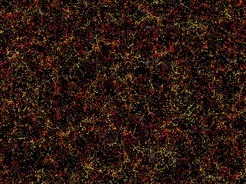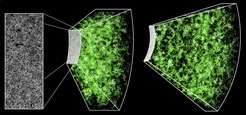What are the properties of Dark Energy? This question is one of the most intriguing ones in astronomy and scientists are one step closer in answering this question with the largest three-dimensional map of the universe so far: This map contains 1.2 million galaxies in a volume spanning 650 cubic billion light years. Hundreds of scientists from the Sloan Digital Sky Survey III (SDSS-III) – including researchers at the Max Planck Institutes for Extraterrestrial Physics and for Astrophyics - used this map to make one of the most precise measurements yet of dark energy. They found excellent agreement with the standard cosmological model and confirmed that dark energy is highly consistent with a cosmological constant.

This is one slice through the map of the large-scale structure of the Universe from the Sloan Digital Sky Survey and its Baryon Oscillation Spectroscopic Survey. Each dot in this picture indicates the position of a galaxy 6 billion years into the past. The image covers about 1/20th of the sky, a slice of the Universe 6 billion light-years wide, 4.5 billion light-years high, and 500 million light-years thick. Colour indicates distance from Earth, ranging from yellow on the near side of the slice to purple on the far side. Galaxies are highly clustered, revealing superclusters and voids whose presence is seeded in the first fraction of a second after the Big Bang. This image contains 48,741 galaxies, about 3% of the full survey dataset. Grey patches are small regions without survey data.

This is a section of the three-dimensional map constructed by BOSS. The rectangle on the left shows a cut-out of 1000 sq. degrees in the sky containing nearly 120,000 galaxies, or roughly 10% of the total survey. The spectroscopic measurements of each galaxy - every dot in that cut-out - transform the two-dimensional picture into a three-dimensional map, extending our view out to 7 billion years in the past. The brighter regions in this map correspond to the regions of the Universe with more galaxies and therefore more dark matter. The extra matter in those regions creates an excess gravitational pull, which makes the map a test of Einstein’s theory of gravity.
For more information about this study, visit: http://www.mpa-garching.mpg.de/361158/news201607b
